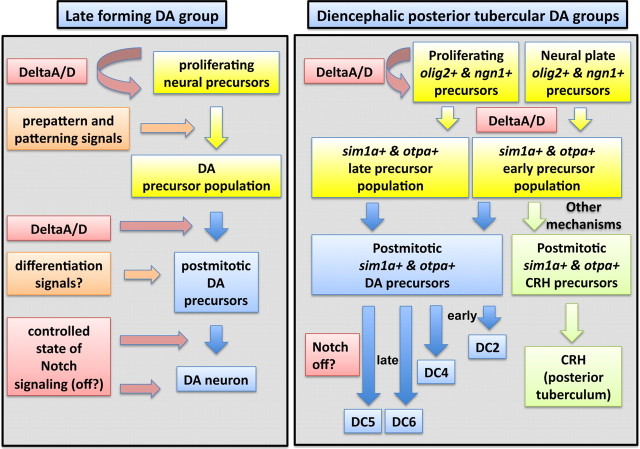Figure 10.
Model of Delta/Notch signaling during dopaminergic development in zebrafish. This study revealed shared and distinct aspects of the earliest differentiating posterior tubercular DA neurons and of other late differentiating DA groups. The left part of the figure presents a model summarizing how Notch signaling may act during neurogenesis of late differentiating neurons that derive from proliferating precursor pools. The patterning and differentiation signals are by and large unknown so far. DeltaA/D appears to be the prominent Notch signal acting to maintain DA precursor pools. DeltaA/D are also involved in the neurogenic switch selecting DA neurons. Our Notch ICD overexpression experiments indicate that Notch signaling should be off during late phases of DA development to enable stable differentiation. The right part of the figure summarizes the effects of Notch signaling we observed for diencephalic posterior tubercular DA neurons, many of which derive already during primary neurogenesis at neural plate stages. DeltaA/D are required to maintain olig2- and ngn1-expressing DA precursors and to regulate the size of the sim1a/otpa-expressing precursor population. These otpa- and sim1a-expressing ventral diencephalic precursors differentiate into DA and CRH neurons. Among the otpa- and sim1a-expressing precursors, DA neurons are selected in temporal sequence, starting with DC2 and DC4 neurons already during late neural plate stages (which may not depend on DeltaA/D for precursor maintenance), and then later DC4, DC5, and DC6 also from proliferating precursor pools. CRH neurons appear to be selected from the same precursor pool, but by unknown mechanisms: these could be other signaling events, or several partially redundant acting Notch ligands other than DeltaA/D, as our survey of Notch ligands did not reveal strong effects on these CRH neurons for any single Notch ligand (data not shown).

